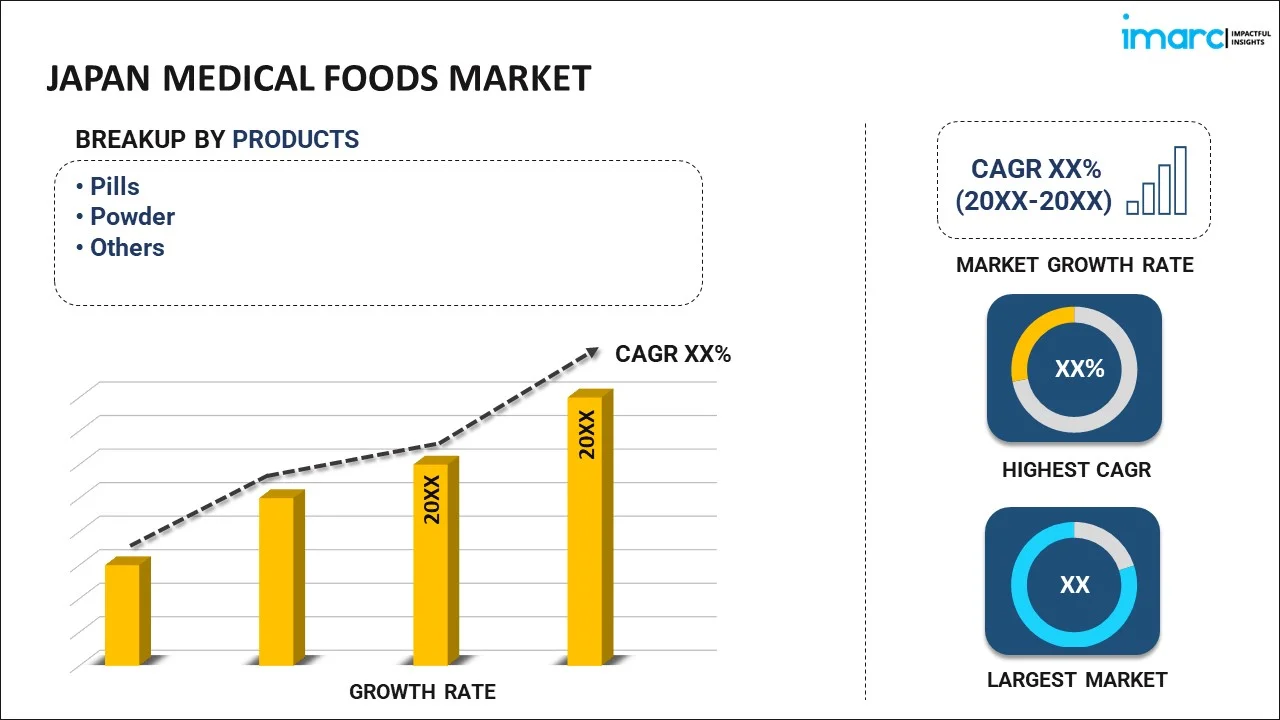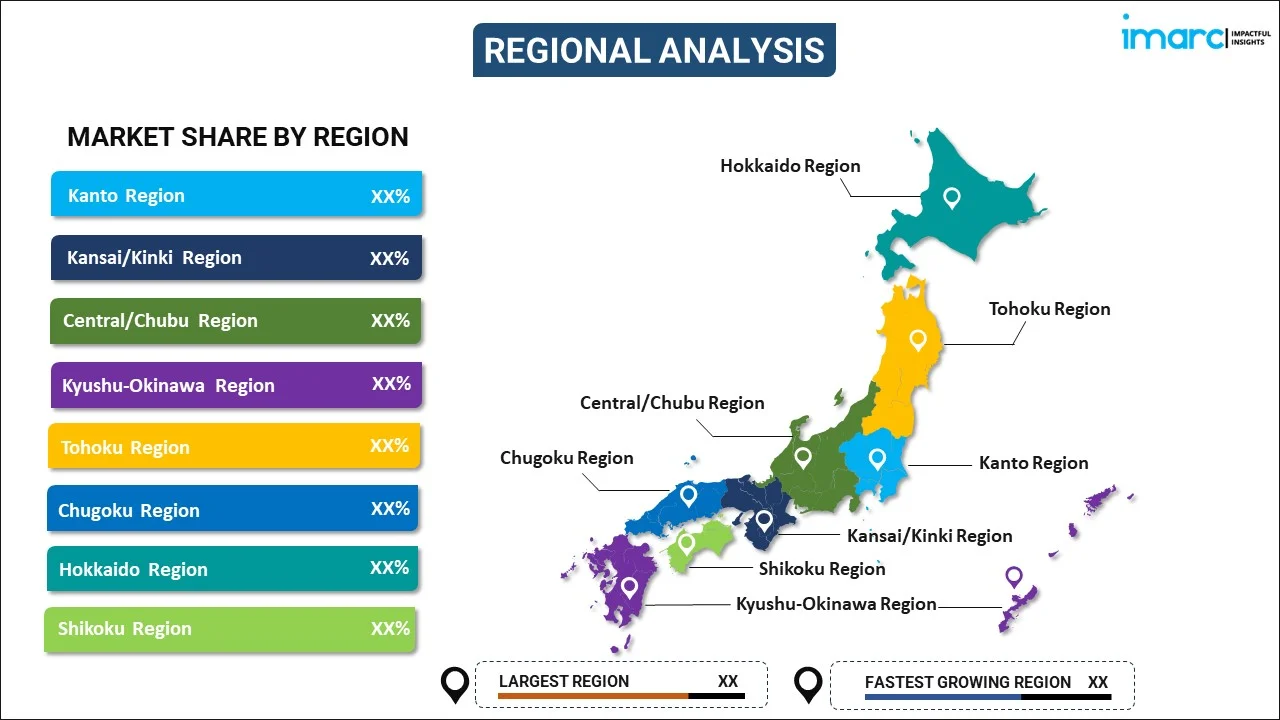
Japan Medical Foods Market Report by Product (Pills, Powder, and Others), Route of Administration (Oral, Enteral), Application (ADHD, Depression, Diabetes, Cancer, Alzheimer's Disease, Metabolic Disorders, and Others), Distribution Channel (Supermarkets, Hospital and Retail Pharmacies, Online Pharmacies, and Others), and Region 2026-2034
Market Overview:
Japan medical foods market size reached USD 1.2 Billion in 2025. Looking forward, IMARC Group expects the market to reach USD 1.9 Billion by 2034, exhibiting a growth rate (CAGR) of 5.47% during 2026-2034. The rapidly aging population and advanced healthcare systems across the country, heightened public awareness about the importance of dietary management in disease conditions, and technological innovations in food science represent some of the key factors driving the market.
|
Report Attribute
|
Key Statistics
|
|---|---|
|
Base Year
|
2025
|
|
Forecast Years
|
2026-2034
|
|
Historical Years
|
2020-2025
|
| Market Size in 2025 | USD 1.2 Billion |
| Market Forecast in 2034 | USD 1.9 Billion |
| Market Growth Rate 2026-2034 | 5.47% |
Access the full market insights report Request Sample
Medical foods are specially formulated and processed products intended for the dietary management of patients with a medical condition or disease. These products are designed to be consumed or administered under the supervision of a healthcare provider. Unlike conventional foods, medical foods are not meant for the general population. They address the unique nutritional needs arising from specific medical conditions, such as diabetes, metabolic disorders, or chronic kidney disease. They are formulated to meet specific nutritional requirements that cannot be achieved by modifying a normal diet. However, it is essential to note that medical foods are not pharmaceuticals, nor are they intended to treat or cure diseases. They function primarily to manage symptoms and conditions, thereby improving the quality of life for patients. As a result, medical foods are gaining immense traction as an integral part of patient care and healthcare strategies across Japan and the world.
Japan Medical Foods Market Trends:
The Japan medical foods market is currently experiencing growth due to a multitude of factors. One of the primary drivers is the country's rapidly aging population. Japan has one of the highest proportions of elderly citizens globally, which naturally leads to an increase in age-related medical conditions like Alzheimer's, diabetes, and chronic kidney disease. This, in turn, has augmented the demand for medical foods as they serve as an important dietary management tool for these ailments. Additionally, the high healthcare standard in Japan represents another major growth-inducing factor. The country's healthcare system is robust and advanced, making it more receptive to integrating medical foods as part of a comprehensive patient care strategy. Healthcare providers are increasingly recommending these specialized foods, creating a sense of trust and acceptance among consumers, thus accelerating product adoption rates. Moreover, technological advancements in the field of food science are significantly contributing to the market growth. Innovations are allowing for the development of more effective and palatable medical foods, which are tailored to meet specific dietary restrictions and nutritional needs. This enhances patient compliance, further fueling market growth. Besides this, the heightened public awareness and education about the importance of dietary management in disease conditions, owing to favorable government initiatives and the role of digital media, is propelling market growth. This has led to more informed choices, with people actively seeking medical foods as a supplementary management option. Furthermore, the regulatory environment in Japan supports stringent quality checks and balances, ensuring that only safe and effective products make it to the market. This regulatory assurance further instills confidence among consumers and healthcare providers alike, thereby driving market growth. Apart from this, strategic collaborations between food manufacturers and healthcare organizations that facilitate research and development (R&D) activities, resulting in product diversification and improvements, are fostering market growth.
Japan Medical Foods Market Segmentation:
IMARC Group provides an analysis of the key trends in each segment of the market, along with forecasts at the country level for 2026-2034. Our report has categorized the market based on product, route of administration, application, and distribution channel.
Product Insights:

To get detailed segment analysis of this market Request Sample
- Pills
- Powder
- Others
The report has provided a detailed breakup and analysis of the market based on the product. This includes pills, powder, and others.
Route of Administration Insights:
- Oral
- Enteral
A detailed breakup and analysis of the market based on the route of administration have also been provided in the report. This includes oral and enteral.
Application Insights:
- ADHD
- Depression
- Diabetes
- Cancer
- Alzheimer's Disease
- Metabolic Disorders
- Others
The report has provided a detailed breakup and analysis of the market based on the application. This includes ADHD, depression, diabetes, cancer, alzheimer's disease, metabolic disorders, and others.
Distribution Channel Insights:
- Supermarkets
- Hospital and Retail Pharmacies
- Online Pharmacies
- Others
A detailed breakup and analysis of the market based on the distribution channel have also been provided in the report. This includes supermarkets, hospital and retail pharmacies, online pharmacies, and others.
Regional Insights:

To get detailed regional analysis of this market Request Sample
- Kanto Region
- Kansai/Kinki Region
- Central/ Chubu Region
- Kyushu-Okinawa Region
- Tohoku Region
- Chugoku Region
- Hokkaido Region
- Shikoku Region
The report has also provided a comprehensive analysis of all the major regional markets, which include Kanto Region, Kansai/Kinki Region, Central/ Chubu Region, Kyushu-Okinawa Region, Tohoku Region, Chugoku Region, Hokkaido Region, and Shikoku Region.
Competitive Landscape:
The market research report has also provided a comprehensive analysis of the competitive landscape in the market. Competitive analysis such as market structure, key player positioning, top winning strategies, competitive dashboard, and company evaluation quadrant has been covered in the report. Also, detailed profiles of all major companies have been provided.
Japan Medical Foods Market Report Coverage:
| Report Features | Details |
|---|---|
| Base Year of the Analysis | 2025 |
| Historical Period | 2020-2025 |
| Forecast Period | 2026-2034 |
| Units | Billion USD |
| Scope of the Report | Exploration of Historical and Forecast Trends, Industry Catalysts and Challenges, Segment-Wise Historical and Predictive Market Assessment:
|
| Products Covered | Pills, Powder, Others |
| Route of Administrations Covered | Oral, Enteral |
| Applications Covered | ADHD, Depression, Diabetes, Cancer, Alzheimer's Disease, Metabolic Disorders, Others |
| Distribution Channels Covered | Supermarkets, Hospital and Retail Pharmacies, Online Pharmacies, Others |
| Regions Covered | Kanto Region, Kansai/Kinki Region, Central/ Chubu Region, Kyushu-Okinawa Region, Tohoku Region, Chugoku Region, Hokkaido Region, Shikoku Region |
| Customization Scope | 10% Free Customization |
| Post-Sale Analyst Support | 10-12 Weeks |
| Delivery Format | PDF and Excel through Email (We can also provide the editable version of the report in PPT/Word format on special request) |
Key Questions Answered in This Report:
- How has the Japan medical foods market performed so far and how will it perform in the coming years?
- What has been the impact of COVID-19 on the Japan medical foods market?
- What is the breakup of the Japan medical foods market on the basis of product?
- What is the breakup of the Japan medical foods market on the basis of route of administration?
- What is the breakup of the Japan medical foods market on the basis of application?
- What is the breakup of the Japan medical foods market on the basis of distribution channel?
- What are the various stages in the value chain of the Japan medical foods market?
- What are the key driving factors and challenges in the Japan medical foods?
- What is the structure of the Japan medical foods market and who are the key players?
- What is the degree of competition in the Japan medical foods market?
Key Benefits for Stakeholders:
- IMARC’s industry report offers a comprehensive quantitative analysis of various market segments, historical and current market trends, market forecasts, and dynamics of the Japan medical foods market from 2020-2034.
- The research report provides the latest information on the market drivers, challenges, and opportunities in the Japan medical foods market.
- Porter's five forces analysis assist stakeholders in assessing the impact of new entrants, competitive rivalry, supplier power, buyer power, and the threat of substitution. It helps stakeholders to analyze the level of competition within the Japan medical foods industry and its attractiveness.
- Competitive landscape allows stakeholders to understand their competitive environment and provides an insight into the current positions of key players in the market.
Need more help?
- Speak to our experienced analysts for insights on the current market scenarios.
- Include additional segments and countries to customize the report as per your requirement.
- Gain an unparalleled competitive advantage in your domain by understanding how to utilize the report and positively impacting your operations and revenue.
- For further assistance, please connect with our analysts.
 Request Customization
Request Customization
 Speak to an Analyst
Speak to an Analyst
 Request Brochure
Request Brochure
 Inquire Before Buying
Inquire Before Buying




.webp)




.webp)












